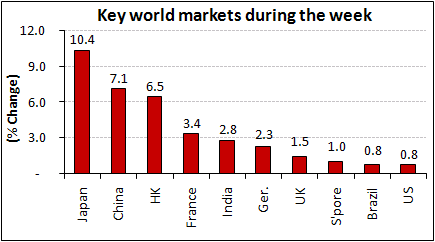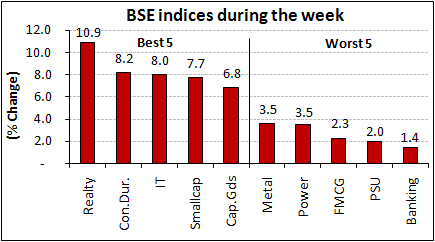- Home
- Todays Market
- Indian Stock Market News December 5, 2009
The world moves past the Dubai debacle Sat, 5 Dec RoundUp
After being beaten down on the back of news of the Dubai debacle during the previous week, stock markets worldwide recorded weekly gains this week. India’s benchmark index, the BSE-Sensex ended the week higher by 2.8%. Gains during the week were on the back of the strong GDP numbers that were announced during the week. In addition, fears surrounding the Dubai debt issue also seemed to be have worn down by the market participants this week.
Moving on to global markets, Asian markets recorded strong gains on a week on week basis. In fact, as per Bloomberg, Asian stocks posted the biggest weekly gain in seven months. This was on the back of receding fears over the Dubai crisis and also on the back of the Bank of Japan stepping in to fight against the current deflationary situation in the country. In fact, the Japanese markets led the gains this week, with its index ending higher by about 10%. It was followed by China and Hong Kong which ended higher by about 7% each. The Americas were amongst the lowest gainers this week, as the US and Brazilian markets recorded gains of only 1% each. France, Germany, UK and Singapore ended the week higher by about 2% to 3%.
 |
| Source: Yahoo Finance |
Coming to the performance of BSE indices, realty stocks were in favour this week as the BSE-Realty index ended higher by about 9%. It was followed by the BSE-Metal and BSE-Healthcare indices which recorded gains of about 7% each. Smallcaps stocks were in demand this week as well, with the BSE-Smallcap Index recording weekly gains of about 7%. Midcap stocks followed suit with the BSE-Midcap Index ending higher by about 5%. While there were no losers this week, stocks forming part of the FMCG, capital goods and consumer durables were amongst the least favoured by investors. While the BSE-FMCG Index ended higher by about 1%, the BSE-Capital Goods and BSE-Consumer Durables indices ended the week with gains of about 2% each.
Moving on to institutional activity during the week, the foreign institutional investors (FIIs) seemed to take full advantage of the fear surrounding the markets following the Dubai debacle as they invested nearly Rs 42 bn (net figure) during the week. The fact that the Indian economy posted strong second quarter numbers also made them buoyant. The domestic mutual funds also were in shopping mood as they invested nearly Rs 29.3 bn (net figure), during the week (barring Friday as data was not available at the time of writing).
 |
| Source: BSE |
Moving on to the key corporate developments during the week – auto numbers for the month of November 2009 were announced during the week. Two-wheelers major, Bajaj Auto reported a strong 73% YoY increase in total volume sales. This includes sales of two and three wheelers. While sales of motorcycles grew by 84% YoY, those of three-wheelers increased by 25% YoY. It may be noted that about 60% of the sales during the month were contributed by the company's Discover and Pulsar brands. On the export front, the company performed well as sales increased by 46% YoY. The company has been able to report such strong growth on the back of its renewed focus and launches aimed at the rural markets.
Two wheeler leader Hero Honda reported a 32% jump in November 2009. It must be noted that this is the eleventh consecutive month wherein the company has sold volumes in excess of 0.3 units. As for sales during the current financial year, the same grew by 21% YoY over the corresponding period last year. As per the company, growth was driven by models across all segments. While the 100 cc segment grew over 20% YoY, the 150 cc and above segment witnessed 30% YoY growth and scooters grew around 40% YoY.
Passenger car major, Maruti Suzuki reported its highest ever monthly sales during the month of November 2009. The company sold over 87,800 vehicles, of which export constituted of nearly 11,500 units. Domestic sales during the same month last year stood at over 47,700 units, representing a 60% YoY increase in volumes (domestic sales). Barring sales of its MUV models (Grand Vitara and Gypsy), the company recorded a year on year increase in all models. In percentage terms, the largest increase was in the C segment (Omni, Versa), which recorded a 116% YoY increase in unit sales. This strong increase in sales could be presumably on the back of increased demand for taxis.
Telecom major Bharti Airtel was in the news this week. A leading business daily reported that the company expressed its concerns over the falling tariff rates by approaching the telecom regular TRAI, asking it to look into the business models of some its peer group companies. The business daily has rightly termed this move as a "rare display of nervousness" by the company. Terming it as ‘predatory pricing', Bharti's management believes that the current tariff structure is lower than the cost structure of operators, and thus completely unsustainable in the long term. It may be noted that recently, even MTNL added a new intensity to competitive tariffs by announcing a half paise-per-second plan for mobile calls on its 2G and 3G networks in Delhi and Mumbai circles. Indeed, competitors do not seem to be on the same page as Bharti. Another large telecom company's management is reported to have said that its company knows the business and has worked out the economics before it has launched the one-paise-per-second plan.
Competition further intensified in the telecom space this week as the newest entrant Uninor, a joint venture between Telenor of Norway and Indian real estate firm Unitech, launched its GSM service across seven circles. This has pushed the tally of players in the Indian telecom market to 14. If any player starts a price war in such a crowded market, others have no choice but to follow. That is a familiar script that has played out in the recent days. Now, Uninor has taken the price war to the next level. It is offering plans such as 29 paise per minute and pay less for talking more. In our view, the rampant price war will not do much good for the financials of the telecom companies. But as in all competition, it is the consumer who wins. That certainly seems to be the case for the Indian telecom user, who is now spoilt for choice.
Concerns regarding the falling market share in the soap segment have been looming over HUL in recent times. This is on the back of competition intensifying with players such as Godrej, Wipro and ITC stepping up their product portfolio. However, a leading business daily has reported that HUL has been able to arrest its falling market share by relaunching various brands. It is believed that HUL embarked on a major brand relaunch exercise this year, under which its soaps like Lifebuoy, Liril, Hamam, Rexona, Breeze and Lux were given new packaging and fragrance. As per data released by AC Neilsen, the company's share in the soap market has marginally risen to 44.7%, up from about 44.5% during the period between August to September.
| Company | 27-Nov-09 | 4-Dec-09 | Change | 52-wk High/Low | |
| Top gainers during the week (BSE-A Group) | |||||
| Jet Airways | 450 | 570 | 26.6% | 606 / 115 | |
| Essar Oil | 122 | 145 | 19.6% | 194 / 60 | |
| Unitech | 75 | 88 | 18.1% | 118 / 25 | |
| Ranbaxy | 432 | 506 | 17.1% | 516 / 133 | |
| Fortis Healthcare | 104 | 121 | 15.9% | 126 / 55 | |
| Top losers during the week (BSE-A Group) | |||||
| Jain Irrigation | 856 | 801 | -6.4% | 930 / 229 | |
| Hindustan Unilever | 284 | 272 | -4.2% | 306 / 211 | |
| Videocon Industries | 231 | 222 | -4.0% | 270 / 82 | |
| Areva T&D | 290 | 281 | -3.2% | 386 / 135 | |
| Zee Entertainment | 265 | 257 | -3.0% | 275 / 88 | |
During the week, the GDP numbers for the quarter ending September were announced. India reported a greater than expected GDP growth of 7.9% during the period. This in turn has elicited comments from experts that India’s GDP for the full year may have to be revised upwards. From an earlier expectation of 6%, a figure of 7% is now being floated around and this seems to have enthused investors. While the upward revision in GDP is indeed a welcome sign, we would like some more clarity to emerge on this front, most notable being the growth in third quarter GDP where the biggest impact of drought is going to be felt. During the previous quarter, the GDP rate stood at 6.1%. The improvement was mainly on the back of a good performance by the industry and service sectors. The manufacturing sector grew by about 9.2% during the second quarter of this fiscal, as compared to a figure of 5.1% last year. Financing, insurance, real estate, and business services rose by 7.7% against 6.4 % during the corresponding quarter last year.
While India's GDP may have grown by 7.9% during the September quarter, one should not ignore that fact that inflation has also been soaring. It is believed that during the third week of November, food inflation rose to 17.5% as against 15.6% a week ago. The reason for the same has been attributed to supply shortages fuelled by weak monsoons this year.
Given that both food prices and foreign inflows have been rising, inflation is set to pose a major challenge to the RBI. As a result, a hike in interest rates seems most likely on the cards. But it remains to be seen when the RBI takes this inevitable step. Given that India's GDP has grown strongly in the last couple of quarters, the central bank certainly has more headroom for increasing interest rates.
For information on how to pick stocks that have the potential to deliver big returns, download our special report now!
Read the latest Market Commentary


Equitymaster requests your view! Post a comment on "The world moves past the Dubai debacle". Click here!
Comments are moderated by Equitymaster, in accordance with the Terms of Use, and may not appear
on this article until they have been reviewed and deemed appropriate for posting.
In the meantime, you may want to share this article with your friends!